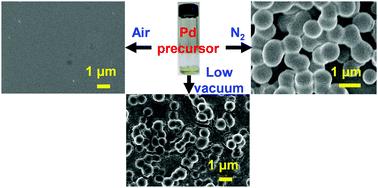Morphology and electrical properties of inkjet-printed palladium/palladium oxide†
Abstract
Inkjet printing is used to deposit palladium films with different morphologies and electrical properties using different precursor thermolysis atmospheres. First, the precursor is reductively decomposed into amine-stabilized palladium clusters. In air, oxygen assists the decomposition of the organoamine ligands for the palladium clusters. Small nanoparticles are formed and fused to smooth films. In nitrogen, the residual ligands facilitate the formation of sub-micron spherical aggregates. In low vacuum, a bilayer film containing a bottom layer with fused nanoparticles and a top layer with spherical aggregates is formed. Such morphology is caused by the competition between the film formation processes in air and in nitrogen. The electrical properties of the films are determined by the whole film for the smooth film and by the bottom layer for the bilayer film. The temperature coefficient of resistance of the films can be adjusted from 0.067% °C−1 to −0.189% °C−1 by tuning the amount of semiconductive palladium oxide in the conduction path. In addition, humid air increases the resistance drift of the films by forming surface-adsorbed hydroxyl groups and/or molecular water. This study highlights the importance of precursor thermolysis atmospheres on the morphology and electrical properties of inkjet-printed palladium/palladium oxide films.



 Please wait while we load your content...
Please wait while we load your content...